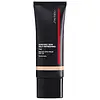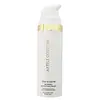Shiseido Synchro Skin Self-Refreshing Tint SPF 20 Versus Artist Couture Prep & Glow Blurring Perfection Primer
What's inside
What's inside
 Key Ingredients
Key Ingredients

 Benefits
Benefits

 Concerns
Concerns

 Ingredients Side-by-side
Ingredients Side-by-side

Ethylhexyl Methoxycinnamate 6.7%
UV AbsorberOctocrylene 3%
UV AbsorberTitanium Dioxide 2%
Cosmetic ColorantWater
Skin ConditioningDimethicone
EmollientGlycerin
HumectantTrifluoropropyldimethyl/Trimethylsiloxysilicate
EmollientCaprylyl Methicone
Skin ConditioningButylene Glycol
HumectantDimethicone/PEG-10/15 Crosspolymer
Sodium Chloride
MaskingSynthetic Fluorphlogopite
Squalane
EmollientHydrogenated Polyisobutene
EmollientThymus Serpyllum Extract
Skin ConditioningDimethicone/Vinyl Dimethicone Crosspolymer
Skin ConditioningPolyquaternium-51
Skin ConditioningSodium Hyaluronate
HumectantHydrolyzed Conchiolin Protein
Skin ConditioningSorbitan Sesquiisostearate
EmulsifyingDisteardimonium Hectorite
StabilisingPEG-10 Dimethicone
Skin ConditioningAluminum Hydroxide
EmollientStearic Acid
CleansingTrisodium EDTA
Hydroxyethyl Acrylate/Sodium Acryloyldimethyl Taurate Copolymer
Emulsion StabilisingLithium Magnesium Sodium Silicate
AbsorbentPolysilicone-2
Sodium Citrate
BufferingDipropylene Glycol
HumectantPolysorbate 60
EmulsifyingIsododecane
EmollientPEG/PPG-19/19 Dimethicone
EmulsifyingBHT
AntioxidantTocopherol
AntioxidantSorbitan Isostearate
EmulsifyingTrimethylsiloxysilylcarbamoyl Pullulan
Polymethylsilsesquioxane
Phenoxyethanol
PreservativeIron Oxides
Mica
Cosmetic ColorantEthylhexyl Methoxycinnamate 6.7%, Octocrylene 3%, Titanium Dioxide 2%, Water, Dimethicone, Glycerin, Trifluoropropyldimethyl/Trimethylsiloxysilicate, Caprylyl Methicone, Butylene Glycol, Dimethicone/PEG-10/15 Crosspolymer, Sodium Chloride, Synthetic Fluorphlogopite, Squalane, Hydrogenated Polyisobutene, Thymus Serpyllum Extract, Dimethicone/Vinyl Dimethicone Crosspolymer, Polyquaternium-51, Sodium Hyaluronate, Hydrolyzed Conchiolin Protein, Sorbitan Sesquiisostearate, Disteardimonium Hectorite, PEG-10 Dimethicone, Aluminum Hydroxide, Stearic Acid, Trisodium EDTA, Hydroxyethyl Acrylate/Sodium Acryloyldimethyl Taurate Copolymer, Lithium Magnesium Sodium Silicate, Polysilicone-2, Sodium Citrate, Dipropylene Glycol, Polysorbate 60, Isododecane, PEG/PPG-19/19 Dimethicone, BHT, Tocopherol, Sorbitan Isostearate, Trimethylsiloxysilylcarbamoyl Pullulan, Polymethylsilsesquioxane, Phenoxyethanol, Iron Oxides, Mica
Water
Skin ConditioningIsodecyl Neopentanoate
EmollientGlycerin
HumectantTalc
AbrasiveOctyldodecanol
EmollientDimethicone
EmollientGlyceryl Stearate Citrate
EmollientHydroxyethyl Acrylate/Sodium Acryloyldimethyl Taurate Copolymer
Emulsion StabilisingMica
Cosmetic ColorantPhenoxyethanol
PreservativePolyacrylate-21
Dimethicone/Vinyl Dimethicone Crosspolymer
Skin ConditioningGlyceryl Stearate
EmollientSodium Polyacrylate
AbsorbentCaramel
Cosmetic ColorantEthylhexylglycerin
Skin ConditioningTocopheryl Acetate
AntioxidantChlorphenesin
AntimicrobialSodium Hydroxide
BufferingSqualane
EmollientSilica
AbrasiveAllantoin
Skin ConditioningCamellia Oleifera Seed Oil
Skin ConditioningPolysorbate 60
EmulsifyingSodium Acrylates Copolymer
Sorbitan Isostearate
EmulsifyingButylene Glycol
HumectantCaprylyl Glycol
EmollientLecithin
EmollientNiacinamide
SmoothingDipropylene Glycol
HumectantCitrus Grandis Peel Oil
MaskingGlyceryl Caprylate
EmollientSodium Hyaluronate
HumectantHydrolyzed Algin
Solanum Lycopersicum Leaf Cell Culture Extract
Skin ConditioningLimonene
PerfumingTin Oxide
AbrasiveCI 77891
Cosmetic ColorantCI 77491
Cosmetic ColorantWater, Isodecyl Neopentanoate, Glycerin, Talc, Octyldodecanol, Dimethicone, Glyceryl Stearate Citrate, Hydroxyethyl Acrylate/Sodium Acryloyldimethyl Taurate Copolymer, Mica, Phenoxyethanol, Polyacrylate-21, Dimethicone/Vinyl Dimethicone Crosspolymer, Glyceryl Stearate, Sodium Polyacrylate, Caramel, Ethylhexylglycerin, Tocopheryl Acetate, Chlorphenesin, Sodium Hydroxide, Squalane, Silica, Allantoin, Camellia Oleifera Seed Oil, Polysorbate 60, Sodium Acrylates Copolymer, Sorbitan Isostearate, Butylene Glycol, Caprylyl Glycol, Lecithin, Niacinamide, Dipropylene Glycol, Citrus Grandis Peel Oil, Glyceryl Caprylate, Sodium Hyaluronate, Hydrolyzed Algin, Solanum Lycopersicum Leaf Cell Culture Extract, Limonene, Tin Oxide, CI 77891, CI 77491
Ingredients Explained
These ingredients are found in both products.
Ingredients higher up in an ingredient list are typically present in a larger amount.
Butylene Glycol (or BG) is used within cosmetic products for a few different reasons:
Overall, Butylene Glycol is a safe and well-rounded ingredient that works well with other ingredients.
Though this ingredient works well with most skin types, some people with sensitive skin may experience a reaction such as allergic rashes, closed comedones, or itchiness.
Learn more about Butylene GlycolDimethicone is a type of synthetic silicone created from natural materials such as quartz.
What it does:
Dimethicone comes in different viscosities:
Depending on the viscosity, dimethicone has different properties.
Ingredients lists don't always show which type is used, so we recommend reaching out to the brand if you have questions about the viscosity.
This ingredient is unlikely to cause irritation because it does not get absorbed into skin. However, people with silicone allergies should be careful about using this ingredient.
Note: Dimethicone may contribute to pilling. This is because it is not oil or water soluble, so pilling may occur when layered with products. When mixed with heavy oils in a formula, the outcome is also quite greasy.
Learn more about DimethiconeThis ingredient is a silicone used to improve the texture of products and absorb oil. It does not get absorbed into the skin.
Like other silicones, Dimethicone/Vinyl Dimethicone Crosspolymer helps condition the skin by creating a barrier. In this sense, it can act as an emollient and trap moisture in.
This ingredient is a type of elastomer.
Learn more about Dimethicone/Vinyl Dimethicone CrosspolymerDipropylene Glycol is a synthetically created humectant, stabilizer, and solvent.
This ingredient helps:
Dipropylene glycol is technically an alcohol, but it belongs to the glycol family (often considered part of the ‘good’ alcohols). This means it is hydrating and gentle on skin unlike drying solvent alcohols like denatured alcohol.
As a masking agent, Dipropylene Glycol can be used to cover the smell of other ingredients. However, it does not have a scent.
Studies show Dipropylene Glycol is considered safe to use in skincare.
Learn more about Dipropylene GlycolGlycerin is already naturally found in your skin. It helps moisturize and protect your skin.
A study from 2016 found glycerin to be more effective as a humectant than AHAs and hyaluronic acid.
As a humectant, it helps the skin stay hydrated by pulling moisture to your skin. The low molecular weight of glycerin allows it to pull moisture into the deeper layers of your skin.
Hydrated skin improves your skin barrier; Your skin barrier helps protect against irritants and bacteria.
Glycerin has also been found to have antimicrobial and antiviral properties. Due to these properties, glycerin is often used in wound and burn treatments.
In cosmetics, glycerin is usually derived from plants such as soybean or palm. However, it can also be sourced from animals, such as tallow or animal fat.
This ingredient is organic, colorless, odorless, and non-toxic.
Glycerin is the name for this ingredient in American English. British English uses Glycerol/Glycerine.
Learn more about GlycerinThis is a synthetic polymer. It helps improve the texture of products by adding thickness and gel-like feel.
It is also an emulsifer, meaning it prevents ingredients such as oil and water from separating. It also helps evenly disperse other ingredients.
Mica is a naturally occurring mineral used to add shimmer and color in cosmetics. It can also help improve the texture of a product or give it an opaque, white/silver color.
Serecite is the name for very fine but ragged grains of mica.
This ingredient is often coated with metal oxides like titanium dioxide. Trace amounts of heavy metals may be found in mica, but these metals are not harmful in our personal products.
Mica has been used since prehistoric times throughout the world. Ancient Egyptian, Indian, Greek, Roman, Aztec, and Chinese civilizations have used mica.
Learn more about MicaPhenoxyethanol is a preservative that has germicide, antimicrobial, and aromatic properties. Studies show that phenoxyethanol can prevent microbial growth. By itself, it has a scent that is similar to that of a rose.
It's often used in formulations along with Caprylyl Glycol to preserve the shelf life of products.
Polysorbate 60 is used to help stabilize products. It is a surfactant and emulsifier. These properties help keep ingredients together in a product. Surfactants help reduce surface tension between ingredients with different states, such as liquids and solids. Emulsifiers help prevent oils and waters from separating.
Polysorbate 60 is sorbitol-based and created from the ethoxylation of sorbitan. Ethoxylation is a chemical reaction used to add ethylene oxide. Sorbitan is a the dehydrated version of sorbitol, a sugar found in fruits.
In this case, the 60 comes from reacting 60 units of ethylene oxide with sorbitan.
Polysorbates are commonly used in medicine and foods.
Learn more about Polysorbate 60Sodium Hyaluronate is hyaluronic acid's salt form. It is commonly derived from the sodium salt of hyaluronic acid.
Like hyaluronic acid, it is great at holding water and acts as a humectant. This makes it a great skin hydrating ingredient.
Sodium Hyaluronate is naturally occurring in our bodies and is mostly found in eye fluid and joints.
These are some other common types of Hyaluronic Acid:
Learn more about Sodium HyaluronateSorbitan Isostearate is an emulsifer and cleaning agent. It is created from isostearic acid and sorbitol.
As an emulsifier, Sorbitan Isostearate prevents oils and water from separating.
Due to its isostearic acid base, it may not be safe for Malassezia or fungal acne.
Learn more about Sorbitan IsostearateSqualane is an emollient that helps the skin hold onto moisture. It's an oily liquid that occurs naturally in certain types of fish and plant oils.
Because squalane boosts hydration in the skin, it also comes with plenty of benefits: it is an antioxidant and can help fight free radicals and skin damage. Squalane is also found to have a detoxifying effect when applied.
Squalane comes from squalene, which occurs naturally within the sebum of our skin. It is one of the oils our skin produces to keep itself hydrated. Squalane is the hydrogenated version of squalene and has a longer shelf life.
Research shows that squalane is non-irritating (even at 100% concentration).
In general, it's a fantastic ingredient. It does a great job at hydrating the skin, and it's suitable for those with sensitive skin.
The source of squalane may impact malassezia / fungal acne. This is because olive oil derived squalane can contain impurities such as fatty acids and plant waxes. Sugarcane derived squalane is recommended for anyone with malassezia concerns.
Is squalane vegan?
This depends on the source. Squalane can be derived from both plants and animals. Most squalane used in skincare comes from plants.
Please note: the source of squalane is only known if disclosed by the brand. We recommend reaching out to the brand if you have any questions about their squalane.
Read more about squalene with an "e".
Is squalane an oil?
Squalane is often called an oil, but it’s technically not; it’s a hydrocarbon, meaning it’s only made of carbon and hydrogen, unlike true oils which are triglycerides made of fatty acids and glycerol.
The term “oil-free” isn’t regulated, so companies can define it however they want. Some exclude all oils, while others just avoid mineral oil or comedogenic oils.
While some people avoid oils thinking they cause breakouts, the right kind of oil (or oil-like ingredient like squalane) can actually help balance and hydrate your skin. It’s worth testing out simple oils or squalane to see what works best for your skin.
Learn more about SqualaneWater. It's the most common cosmetic ingredient of all. You'll usually see it at the top of ingredient lists, meaning that it makes up the largest part of the product.
So why is it so popular? Water most often acts as a solvent - this means that it helps dissolve other ingredients into the formulation.
You'll also recognize water as that liquid we all need to stay alive. If you see this, drink a glass of water. Stay hydrated!
Learn more about Water